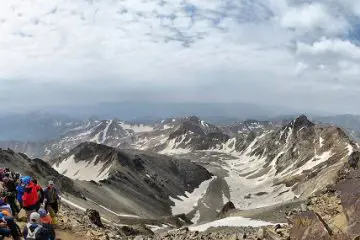Going rock-climbing on Iran’s most technical big wall on Alam Kuh? So, having a primary familiarity with 3 of its most common routes will come in handy in choosing your preferred route and having a safe ascent of it. To learn more about 3 of Alam Kuh’s big wall routes, Harry Rost-Alaee Route, the French Route, and Polish route 52, join me on this post…

Alam Kuh’s Big Wall Routes
Depending on your professionality and physical capabilities, you can choose from the many routes on Alam Kuh’s big wall: Harry Rost-Alaee Route, the French Route, and Polish route 52. Here they are:

Harry Rost-Alaee Route
One of Alam Kuh’s big wall routes is on the left side of Alam’s big wall, next to the peak, and inside the small gap of the wall: Harry Rost-Alaee Route. It includes 2 overarching faces (one big and one small) and its difficulty level is 5.9. Because it is inside the gap, sunlight doesn’t reach it in most of its pitches. So, you need to wear suitable clothing that protect you against the cold.
The route includes 11 pitches. If you ascend the two 25-meter pitches of the beginning of the route, the pitches will be 10. After passing the first 3 pitches, you’ll reach the bottom of the big overarching face which is anchored and can be aid climbed (but if you are very capable, you can free climb it too). On the next pitch, after a free climb, part of the route has a small overarching face. Then you’ll get deeper into the gap and the icy area. Use bridging technique to climb this icy and snowy area. The next pitch intersects with the French Route. Use layback technique for climbing this part. The rest of the route is normal and you can find pitons. After the last pitch, which is a vertical wall of about 15 to 20 meters.

Watch OUT!
You’ll get to a dangerous part with unstable rocks. You have to be very careful after this part. Most accidents on Alam’s big wall routes happen on this section. The reason is that climbers are tired and want to speed up the climb, so they detach themselves from the rope or don’t take belaying seriously. Compared to the other routes, the length of this part is longer on Harry Rost route. There are old fixed ropes there that you should avoid putting the pressure of your weight on them. The route ends after this part and below the summit.
The French Route
Another of Alam’s big wall routes is the French Route. This route meets Harry Rost Route for half of the way. Having passed the icy and snowy area (before Sekooh), you’ll reach Arash Ledge and the large traverse. After passing two 6-meter pendulums, you’ll reach the beginning of Gorbero (a very narrow passage). After the first and the second Gorbero, you’ll get to Ghomghomeh Ledge. Then the 40-meter traverse leads you to the central gap. Aid climbing inside the gap takes you to the dangerous part with unstable rocks. This part has a common anchoring area with Shokooh Route. The part with the unstable rocks directs you to the summit. The difficulty of the French Route is 5/10 a, IV.

Note: When they enter the crack, most climbers make the mistake of following the Hamedani Route instead of the French Route. The French Route is totally inside the gap and the color of the rock inside the gap is slightly different from outside it.
Important Note: You’d better plan your ascent in a way that you are out of the area with the unstable rocks before it gets dark. Reaching this area after sunset is very dangerous. So, you should either spend the night in Siah Sang Hut or Khorasan Hut or stay at Ghomghomeh Ledge.
The Polish Route 52
As one of Alam Kuh’s big wall routes, Polish route 52 has 2 parts. The first part extends to Ghomghomeh Ledge and the second past stretches between Ghomghomeh Ledge to the summit. Up to this time, the second part of this Polish route has only been ascended twice, once by Hasan Najjarian and once by Kazem Faridian and Afshin Yousefi. Most climbers who choose the 52 Route, choose to continue from either the French Route (inside the gap) or Shokooh Route. The first part of the route, up to the ledge, there are 9 pitches. Free climbing is usually used for climbing the first pitch, but the rest are climbed with aid. The difficulty level of Polish Route 52 is 5/10 a, A1.









Comments